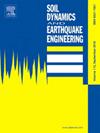基于dmt的液化触发程序考虑了细粒含量的影响
IF 4.2
2区 工程技术
Q1 ENGINEERING, GEOLOGICAL
引用次数: 0
摘要
基于现场试验结果的半经验图的应用是地震诱发土壤液化评价的第一步。其中,近几十年来,特别是2010-2011年新西兰坎特伯雷地震之后,基于cpt的海图得到了很大的发展,而现有的基于DMT方法的主要缺点是缺乏对细粉含量的校正因子。为此,本研究提出了考虑细粒含量影响的循环阻力比与水平应力指数之间新的经验关系。新方法是在位于Emilia- romagna平原(意大利)的特定地点进行校准的,在那里,通过现场和实验室测试,可以对2012年Emilia地震后受液化影响的粉砂和砂质粉砂沉积物进行广泛的土壤表征。将考虑细粒含量效应的新曲线的性能与以往提出的“净砂”曲线的性能以及最新的基于cpt方法的性能进行了比较。尽管仅针对意大利特定的土壤进行了验证,并且需要进一步的现场验证,但所提出的方法似乎有望改善基于dmt的粉质砂液化评估。本文章由计算机程序翻译,如有差异,请以英文原文为准。
DMT-based liquefaction triggering procedure accounting for the fines content effect
The application of semi-empirical charts based on in-situ testing results represents the first step in the earthquake-induced soil liquefaction assessment. Among them, the CPT-based charts have been largely developed in the last decades, especially after the 2010–2011 Canterbury earthquakes in New Zealand, while the main drawback of the existing approach based on DMT is related to the lack of a correction factor for the fines content. In this regard, this study proposes a new empirical relationship between the cyclic resistance ratio and the horizontal stress index where the effects of the fines content are incorporated. The new method is calibrated on specific sites located in the Emilia-Romagna plain (Italy), where an extensive soil characterization from in-situ and laboratory tests was available for the silty sand and sandy silt deposits affected by liquefaction after the 2012 Emilia earthquake. The performance of the new curve accounting for the fines content effect is compared with that obtained by adopting the “clean sand” curves proposed in the past, as well as with that obtained by using the most recent CPT-based method. Even though verified only for specific Italian soils and requiring further field validation, the proposed approach appears as promising to improve the DMT-based liquefaction assessment in silty sands.
求助全文
通过发布文献求助,成功后即可免费获取论文全文。
去求助
来源期刊

Soil Dynamics and Earthquake Engineering
工程技术-地球科学综合
CiteScore
7.50
自引率
15.00%
发文量
446
审稿时长
8 months
期刊介绍:
The journal aims to encourage and enhance the role of mechanics and other disciplines as they relate to earthquake engineering by providing opportunities for the publication of the work of applied mathematicians, engineers and other applied scientists involved in solving problems closely related to the field of earthquake engineering and geotechnical earthquake engineering.
Emphasis is placed on new concepts and techniques, but case histories will also be published if they enhance the presentation and understanding of new technical concepts.
 求助内容:
求助内容: 应助结果提醒方式:
应助结果提醒方式:


